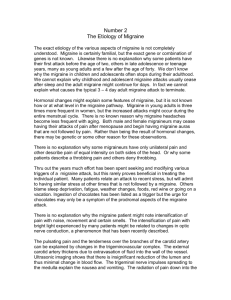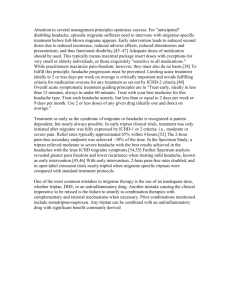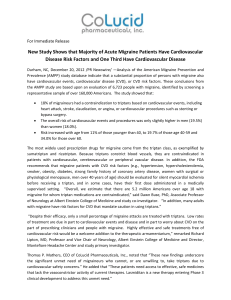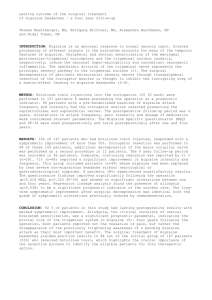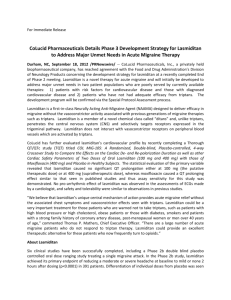Supplementary Information Analysis of Functional Connectivity The
advertisement
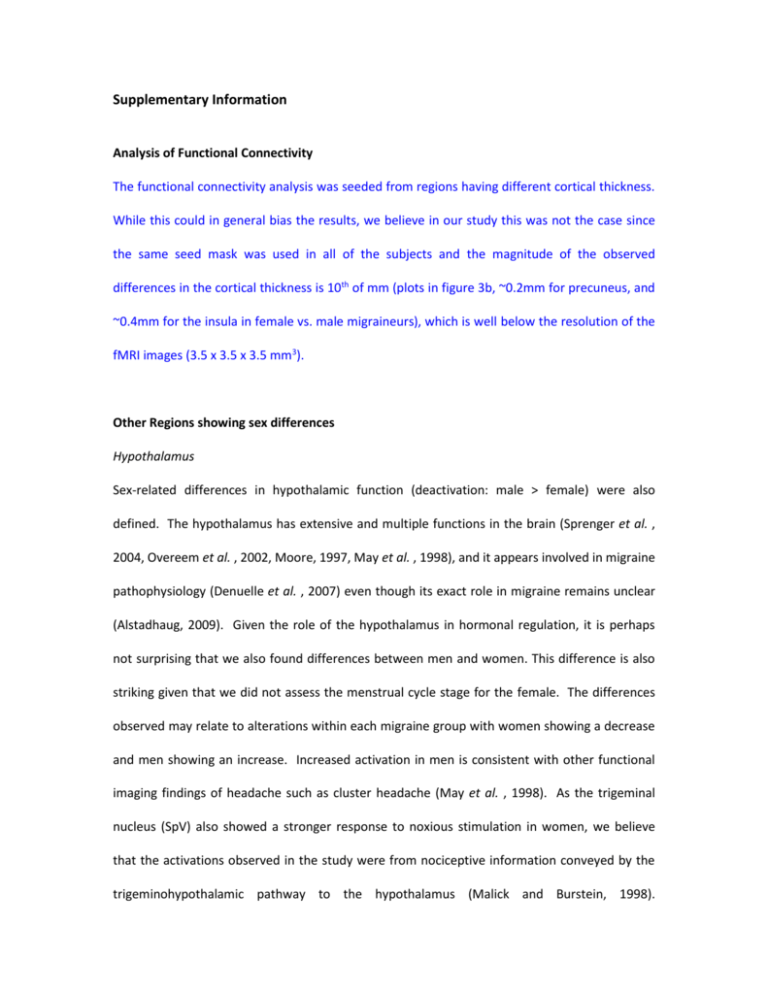
Supplementary Information Analysis of Functional Connectivity The functional connectivity analysis was seeded from regions having different cortical thickness. While this could in general bias the results, we believe in our study this was not the case since the same seed mask was used in all of the subjects and the magnitude of the observed differences in the cortical thickness is 10th of mm (plots in figure 3b, ~0.2mm for precuneus, and ~0.4mm for the insula in female vs. male migraineurs), which is well below the resolution of the fMRI images (3.5 x 3.5 x 3.5 mm3). Other Regions showing sex differences Hypothalamus Sex-related differences in hypothalamic function (deactivation: male > female) were also defined. The hypothalamus has extensive and multiple functions in the brain (Sprenger et al. , 2004, Overeem et al. , 2002, Moore, 1997, May et al. , 1998), and it appears involved in migraine pathophysiology (Denuelle et al. , 2007) even though its exact role in migraine remains unclear (Alstadhaug, 2009). Given the role of the hypothalamus in hormonal regulation, it is perhaps not surprising that we also found differences between men and women. This difference is also striking given that we did not assess the menstrual cycle stage for the female. The differences observed may relate to alterations within each migraine group with women showing a decrease and men showing an increase. Increased activation in men is consistent with other functional imaging findings of headache such as cluster headache (May et al. , 1998). As the trigeminal nucleus (SpV) also showed a stronger response to noxious stimulation in women, we believe that the activations observed in the study were from nociceptive information conveyed by the trigeminohypothalamic pathway to the hypothalamus (Malick and Burstein, 1998). Hypothalamic responses may also be a result of altered stress/autonomic responses (Goldstein et al. , 2010, Nunn et al. , 2011) or hypothalamic priming resulting from differences in cyclic hormonal processes (Goldstein et al. , 2005). Basal Ganglia Alteration in morphology and function of the basal ganglia is present in migraineurs (Maleki et al. , 2010a). The basal ganglia play an important role in multiple functions (Herrero et al. , 2002) including pain processing (reviewed in (Moulton et al. , 2011)). In the present study, we observed deactivation of nucleus accumbens (NAc) for both male and female migraineurs in response to painful stimulation that was more significant in men. We also found stronger activation responses in bilateral caudate (F>M) and contra-lateral putamen (M>F). In our previous studies we had observed altered functional connectivity in the caudate of high vs. low frequency migraineurs (7 female: 3 male in each cohort) and we also had observed decreased volumes in adult migraineurs with high frequency vs. low frequency migraines (Maleki et al. , 2010a). While alterations in basal ganglia circuits are common in pain imaging studies (Borsook et al. , 2010) and reports of alterations in iron accumulation in migraineurs in the putamen and globus pallidus (Kruit et al. , 2009), the reason for the sex differences are unclear. Putaminal activation may correlate with an anti-algesic or analgesic process since it is also activated in phMRI analgesic studies (Upadhyay et al. , 2011) while prior pain or migraine imaging studies have not reported specific sex differences in the basal ganglia. Pathways that originate in the trigeminovascular systems may send collaterals to the basal ganglia (Noseda et al. , 2011), but it is not known how these may impact on sex differences except that differences in neurotransmitter systems may be present in men and women as described in other pathological conditions affecting the brain (Tayoshi et al. , 2009). Also noted were differences in the ventral striatum (nucleus accumbens) where greater deactivation was observed for men vs. women. We have observed deactivation in the region in response to heat in healthy subjects and have interpreted this as a measure of hedonic responses to aversive stimuli (Becerra et al. , 2001, Becerra and Borsook, 2008). In chronic pain patients, the activity in the region in response to noxious heat may encode predicted value of pain and anticipates its analgesic potential on chronic pain (Baliki et al. , 2010). Posterior Cingulate Significant differences in BOLD responses to pain were observed in the posterior cingulate with activations for women greater than men (Table 3). The posterior cingulate receives afferent inputs from the anterior thalamic nuclei and from extensive cortical areas in the frontal, parietal, and temporal lobes (Vogt et al. , 1979). It has been suggested that the region is involved in components of a self-reflection/self-regulation (Johnson et al. , 2006). Alterations in posterior cingulate volume in healthy subjects (greater in women) (Mann et al. , 2011) and in migraine (smaller in healthy) have previously been reported (Kim et al. , 2008). In the latter study (Migraine: 20 (3 male/17 female) vs. Healthy Control 33 (4 male/29 female)), this was reported to correlate with decreased metabolic measures in the same area (Kim et al. , 2010). The posterior cingulate is also activated by light (Boulloche et al. , 2010) and by olfactory stimuli in interictal migraineurs (Demarquay et al. , 2008) suggesting that it may be part of brain regions sensitized in the migraine condition. Activation as demonstrated by PET imaging during migraine has also supported posterior cingulate activation (Afridi et al. , 2005). Again, the present finding that female migraineurs had a more reactive posterior cingulate than male migraineurs may indicate more severe disease consequences in women. In contrast to areas involved in emotional processing of pain, we also observed changes in the primary somatosensory cortex (SI). Previous fMRI studies on sex differences in healthy subjects indicate that men have greater pain activation of the somatosensory cortex (Derbyshire et al. , 2002, Moulton et al. , 2006, Paulson et al. , 1998, Straube et al. , 2009, Kong et al. , 2010). Our results also show significant difference in the pain activation (women < men) of the contralateral somatosensory cortex while no differences were observed in the ipsilateral SI. This observation was seen even though no differences in pain intensity were measured between the two migraine groups. We interpret this difference in terms of other systems that modulate or dampen pain intensity including those abnormalities discussed above. Study limitations Measure of Menstrual Period Although menstrual cycle stage was not measured in these experiments, the addition of a monthly menstrual related pain may also further sensitize or aggravate pain circuits in women independent of whether their migraine is paired with the onset of their menstrual period. Future studies should utilize repeated measures across the menstrual cycle and/or measure gonadal hormone levels, as well as detailed exploration of sex related pain expectations (Vierhaus et al. , 2010). Head Size The issue of head size and sex is complex when utilizing MRI measures of gray matter volume may be a confound with between-subject comparisons (Barnes et al. , 2010). As it is known that men generally have larger volumes and thinner cortex than women, we adjusted for this by normalizing volumes. Specifically, structural neuroimaging of healthy humans also report gray matter differences between men and women areas of the cortical mantle are thicker in women than in men (Cahill, 2006), particularly in the posterior medial wall (Luders et al. , 2006). Women have larger volumes, relative to cerebrum size, in frontal and medial paralimbic cortices, where as men have larger volumes, relative to cerebrum size, in frontomedial cortex, the amygdala and hypothalamus (Goldstein et al. , 2001). In this study we compared matched healthy men and women to account for such disparities. In doing so, none of the changes reported in the migraine groups were observed. Number of Subjects The number of subjects studied is relatively small. There was a three-way match for the study: migraine men and women (age, migraine frequency, medications) and for migraine sex and healthy controls (age and sex). However all analysis, including structural MRI or fMRI datasets, were performed using rigorous statistical tests. Specifically, for fMRI we implemented a mixedeffects group analysis to incorporate individual variability into the second level (cohort-level) statistics. We performed inference utilizing robust adaptive techniques, such as, Gaussian mixture modeling to determine statistical significance minimizing false positive as well as false negatives. Morphometric statistical inference were performed based on standard techniques (general linear model) and the vertex-based cortical thickness comparisons were corrected for multiple comparisons using a Monte-Carlo based simulation for multiple comparisons. Other Structural Abnormalities Structural changes associated with migraine are not limited to the gray matter and multiple studies have reported either the presence of white matter abnormalities of the brain of migraine patients in the form of focal hyperintense lesions using magnetic resonance imaging or changes diffusion properties (ex. reduced fractional anisotropy (FA)) of specific white matter fibers (ex. optic radiation (Rocca et al. , 2008), trigeminothalamic white matter tract (DaSilva et al. , 2007)) in migraineurs without aura have lower fractional anisotropy in the ventrolateral periaqueductal grey matter. While We did not explore white matter differences in these cohorts, there hasn’t been any report on gender specific differences in white matter abnormalities and may be that's something that should be explored in the future studies. Medication Use Finally, as with many studies that compare healthy controls with a disease state, the issue of medication use remains a confound. In this study, migraine some patient were on either triptans or non-steroidal anti-inflammatory drugs (NSAIDS). In comparing male and female migraineurs, we tried to control for this confound by matching subjects in terms of the type and the history of the medications that they had used. However for the comparisons between migraineurs and healthy control subjects, we cannot rule out direct triptan-mediated effects. Supplementary Figures Supplementary Figure 1: Direct within sex comparisons. Significant clusters from vertex-wise with gender cortical thickness comparisons for disease-only effect in female healthy vs. female migraineur subjects (left column) and in male healthy vs. male migraineur subjects (right column). The blue-light blue colors represent areas with cortex thicker in female migraineurs vs. female healthy control subjects. There were no significant differences in cortical thickness between male migrianeurs vs. male healthy control subjects. Supplementary Figure 2: Functional Connectivity in Male and Female Subjects. The blue-light blue colors represent areas with negative correlation and red-yellow colors represent positive correlations between insula and precuneus with the rest of the brain.

